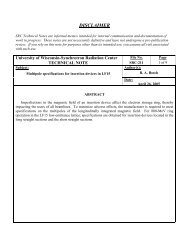SRC Users' Meeting - Synchrotron Radiation Center - University of ...
SRC Users' Meeting - Synchrotron Radiation Center - University of ...
SRC Users' Meeting - Synchrotron Radiation Center - University of ...
Create successful ePaper yourself
Turn your PDF publications into a flip-book with our unique Google optimized e-Paper software.
ELECTRONIC PROPERTIES OF MN-SILICIDE ON SI(111)<br />
J. J. Paggel, K. Schwinge, G. Ctistis, U. Deffke, and P. Fumagalli<br />
Institut für Experimentalphysik, Freie Universität Berlin, Germany<br />
T. Miller and T.-C. Chiang<br />
Department <strong>of</strong> Physics, <strong>University</strong> <strong>of</strong> Illinois at Urbana-Champaign, IL<br />
and<br />
Frederick-Seitz Materials Research Laboratory, <strong>University</strong> <strong>of</strong> Illinois at Urbana-Champaign, IL<br />
The electron spin as new degree <strong>of</strong> freedom in electronics is widely discussed. One<br />
central problem is spin-injection into the semiconductor material, i.e. the transfer <strong>of</strong> the spinpolarization<br />
from the magnetic electrode into the semiconductor. It is generally believed that<br />
structural disorder at the interface will lower the injection efficiency. In order to achieve high<br />
spin-polarization in the semiconductor, epitaxial, magnetic films on semiconductors are therefore<br />
sought after.<br />
Mn – in its conventional antiferromagnetic -phase – might be a promising candidate for<br />
magnetic films on silicon. Its fcc-phase is lattice matched to Si. There is even a large probability<br />
for Mn to be ferromagnetic at RT in this phase. Growing Mn-films on Si(111) yields epitaxial<br />
films with six-fold symmetry. Auger electron spectroscopy indicates a large Si-content <strong>of</strong> the<br />
films, maybe even a Si surface layer. RHEED and STM indicate closed films <strong>of</strong> good quality.<br />
The nature <strong>of</strong> these films could not be revealed using our laboratory experiments. Photoelectron<br />
spectroscopy experiments, reported here, identify the film as metallic Mn-silicide. The bonding<br />
character between Mn and Si is largely covalent. The Si2p core-level from the silicide is very<br />
simple and shows a striking similarity to the core-level <strong>of</strong> the famous Si(111)-(77)<br />
reconstruction, turning the interest from potential application <strong>of</strong> the films to basic research, as the<br />
electronic properties <strong>of</strong> the Si(111)-(77) are still under debate. The Si(111)-(77) reconstruction<br />
shows at least two nearly dispersionless surface states, associated with adatoms, which are also<br />
identified as origin for the prominent surface core-level <strong>of</strong> the Si(111)-(77) reconstruction. The<br />
Si2p core-level from the silicide shows a similar surface component, such that an adatom surface<br />
state was expected. The latter has not been found yet.<br />
This work was funded by the Deutsche Forschungsgemeinschaft through SFB 290 and<br />
grant Pa661/5-1, the U.S. National Science Foundation (grant DMR-02-03003), the U.S.<br />
Department <strong>of</strong> Energy, Division <strong>of</strong> Materials Sciences (grant DEFG02-91ER45439), and the<br />
Petroleum Research Fund, administered by the American Chemical Society. The <strong>Synchrotron</strong><br />
<strong>Radiation</strong> <strong>Center</strong> is supported by the National Science Foundation under grant DMR-00-84402.
















